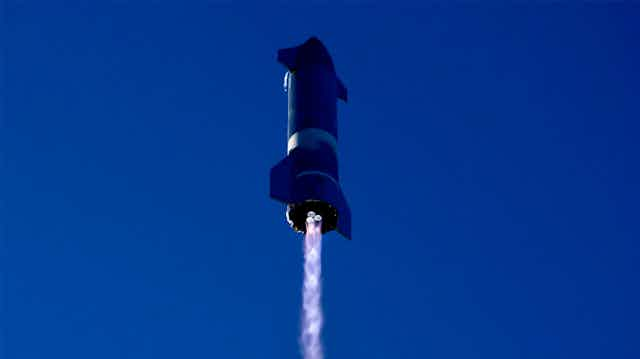Private company SpaceX launched SN8, a prototype of its Starship spacecraft, designed to go to the Moon and Mars, on December 10. Its short flight attracted a great deal of attention for it’s final few seconds before landing – when it exploded.
But consider the near perfect totality of its six-and-a-half-minute flight. Look at the groundbreaking technology and manoeuvres involved. It is reasonable to view this as a hugely successful test.
Ordinary spacecraft return to Earth by using the “aerodynamic drag” in the atmosphere to slow their re-entry. Decelerating from 20,000 mph dissipates a lot of heat which is why they carry heat shields, and the final touchown is controlled by parachutes. The actual rocket engines don’t make a safe landing – they burn up and crash into the sea.
This is a real waste of resources. SpaceX’s founder and CEO Elon Musk is instead trying to reuse as much of the spacecraft as possible. If your ultimate destination is the Moon and onward to Mars, this makes a lot of sense because you can much more easily refuel at judicious locations along the way than build a new rocket.
Starship is a fully reusable rocket system designed to carry 100 tonnes of cargo into Earth orbit and beyond. It has a “booster” first stage which propels it into orbit and separates. The booster stage is designed to land safely and to be reused. SpaceX figured out how to do this with the Falcon rocket, but that’s only two thirds of the system. With Starship, the third of the system that helps propel the spacecraft further than Earth orbit is never ejected.
Landing the first stage booster is “easy” because it is ejected two minutes after launch and therefore returns to Earth from a relatively low altitude – never reaching super high speeds. NASA defines “high” hypersonic speed as a “Mach number” from 10 to 25. The booster only reaches about Mach 6.
Starship itself will be returning from orbit, reaching Mach 25. At this speed, the heat of reentry will melt the engines off. You therefore need a substantial heat shield which dissipates 99% of the energy – protecting the cargo and those all-important rockets that you need for landing. NASA’s partially reusable Space Shuttle had huge wings used to glide the vehicle onto a runway. But wings are heavy and they reduce the potential payload capacity. Also, they won’t work on Mars or the Moon because there’s a lack of atmosphere – and runways.
Belly-flop dynamics
The ingenuity of Starship is that it just “belly-flops” all the way down – a type of free fall in which the atmosphere gradually slows down its speed. As it nears the ground, it should be slow enough for a short flip-and-landing burn to touch down softly on the pad.

No other vehicle flies like this on purpose. Planes are designed to keep the air flow attached to the wings to provide lift. If you lose that air flow, you fall out of the sky – a condition called stall. Starship enters the atmosphere at a 90 degree angle. That means it is fully stalled. Just as a leaf flutters to the ground this is an inherently unstable configuration and the aerodynamics are impossible to predict.
This is where active control comes in. Starship has four flaps and they’re used just as a skydiver uses their four arms to control free fall. With the SN8 test flight, Space X has shown that it’s possible to control a belly-flop. The drop from 12.5km gave SpaceX the conditions of the last half of a return back from orbit.
SpaceX will have gathered flight data that allows it to know how the aerodynamics of a belly-flop work. In particular, it will know how well the flaps work and how precisely to keep the craft stable and land it on target. We can see on the videos released by SpaceX that the flaps are under good control. This looks like great news for SpaceX.
Rocket equation
Being fully reusable, Starship should work out far cheaper than conventional single use craft. But it’s a tricky business to work out exactly how much fuel you need to carry. Conventional aircraft always take off with a bit of fuel to spare, but they can always make an emergency landing if they miscalculate.
Rockets need to launch with an enormous amount of fuel just to be sure you have enough for the landing. It’s like going on a 14-day camping trip and spending 13 days carrying the water for your last day. It’s likely that the tank for SN8 was almost completely empty when it came in to land.
The amount of fuel you need is given by “the rocket equation”. This shows that if you want to launch 100 tonnes of payload to the Moon at a speed of 12,000 metres per second you need a staggering 2,000 tonnes of fuel.
When it comes to the type of fuel, it’s interesting that kerosene and hydrogen (as used by Apollo 11) are still the most popular rocket fuels around. The laws of physics and chemistry haven’t changed very much in fifty years. But Starship is actually pioneering the use of methane as a fuel. Despite being harder to work with, it gives a bit more thrust. And perhaps more importantly there’s plenty of methane on Mars, which is obviously the ultimate destination for SpaceX.
So why did SN8 crash? You can see in the video some green flashes just before landing. The engines are made with copper, which burns with a characteristic green flame. SpaceX says there was a problem with fuel pressure just at the last moment, meaning the rocket couldn’t slow down. The resulting excess oxygen started burning up the engines themselves. If it weren’t for the last few seconds then the landing could have been perfect. Engineers will now be looking to fix that problem for SN9.

